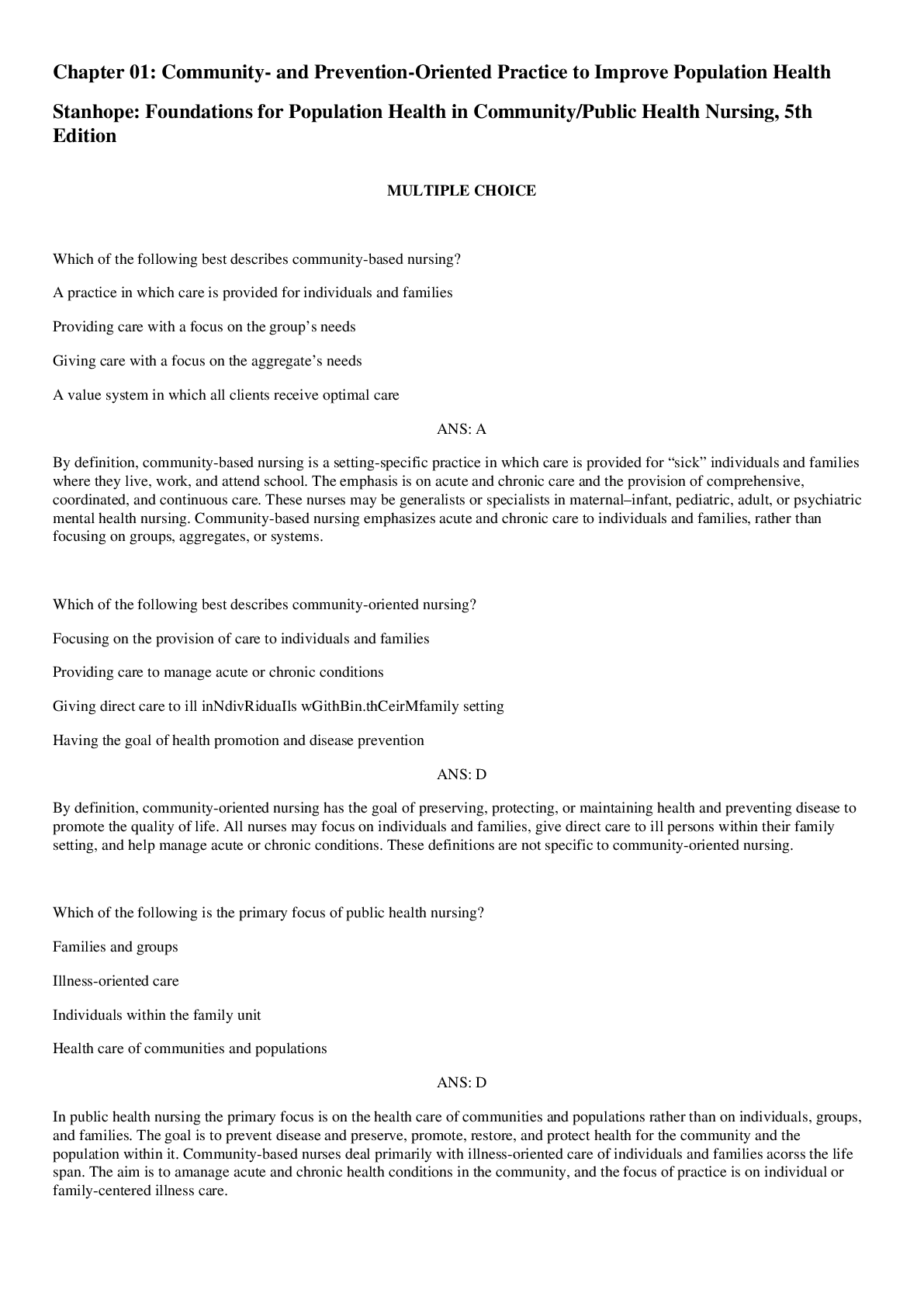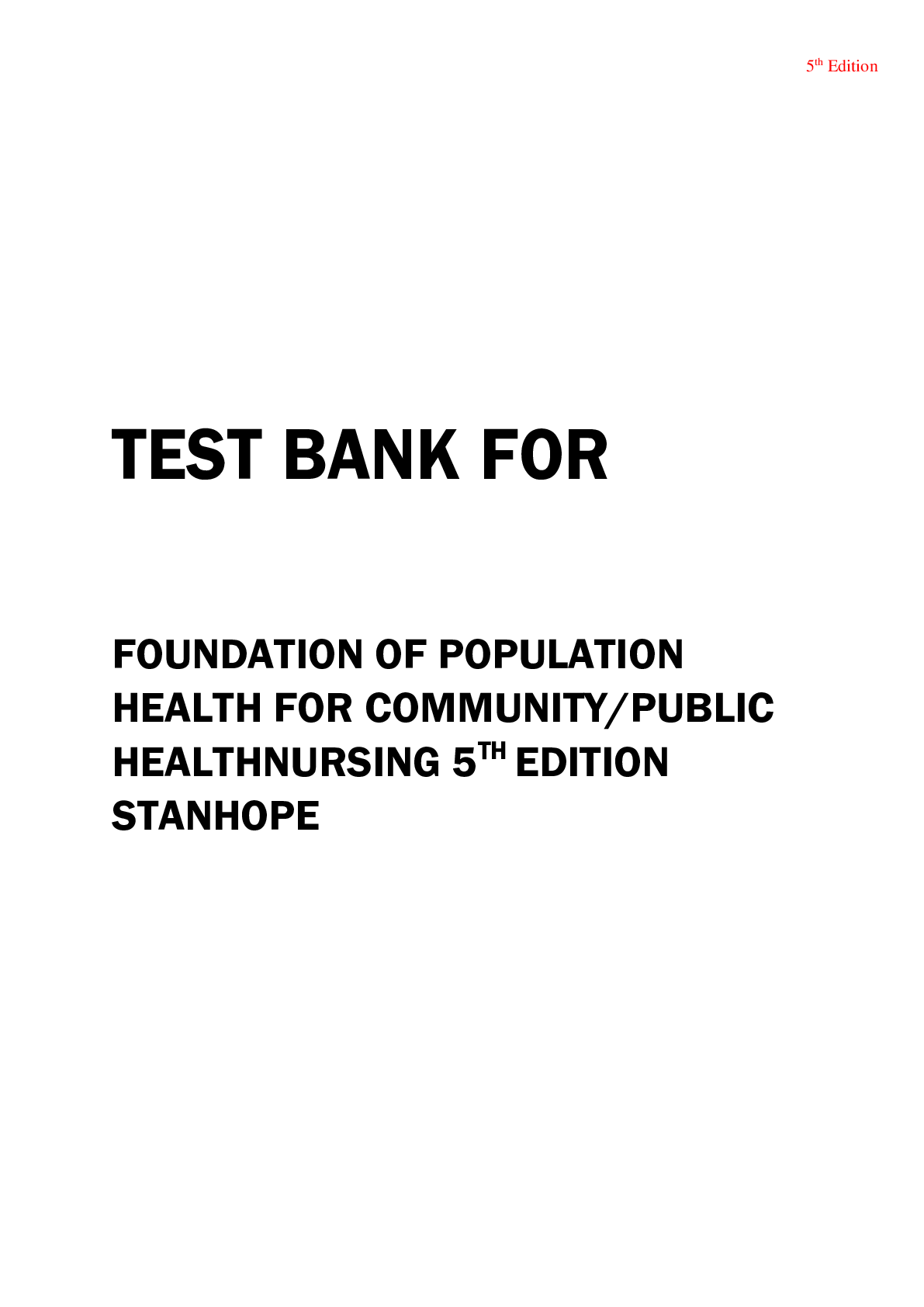*NURSING > TEST BANK > The Nurse in Occupational Health Stanhope: Foundations of Population Health for Community/Public Hea (All)
The Nurse in Occupational Health Stanhope: Foundations of Population Health for Community/Public Health Nursing, 5th Edition,100% CORRECT
Document Content and Description Below
The Nurse in Occupational Health Stanhope: Foundations of Population Health for Community/Public Health Nursing, 5th Edition MULTIPLE CHOICE 1. An occupational health nurse sees the various in... juries and diseases that persons can acquire from employment. Which of the following recommendations would the nurse most likely provide about safety in the workplace? a. Find employment in physical labor; at least your body will be in good condition. b. Professional positions are the safest choice for employment. c. White collar positions provide the least risk for injury. d. There is no “safe” occupation or profession. ANS: D Most adults spend about one third of their time at work. No work is completely risk free. Every single industry grapples with serious hazards related to work. 2. A nurse who works for a hospital in employee health notes that several nurses from one unit have missed work after contracting a communicable disease from a patient. Which of the following best describes the host factor? a. Each sick nurse b. The communicable disease c. The hospital d. The patient ANS: A NURSINGTB.COM Each worker represents a host within the worker population group. The communicable disease and the patient are considered the agent, the factor associated with the illness or injury. The hospital is part of the physical environment. 3. Which of the following groups should the occupational health nurse devote the most time to regarding education and follow-up evaluation? a. New workers employed less than 1 year b. Older workers with chronic illnesses c. Older workers with diminished hearing d. Women in their childbearing years ANS: A The population group at greatest risk for experiencing work-related accidents with subsequent injuries is new workers with less than 1 year of experience on the current job. Because of the inherent risks, the nurse should spend extra time with this group to decrease risk. Older workers with more experience are less likely to experience injury even if they have underlying issues of chronic disease. Women on childbearning age are not at any greater risk than the general population of employees. 4. An employee in a laboratory drops a flask, resulting in a chemical splash into the employee’s eyes, which in turn results in burns to the eyes. Which of the following would be considered the agent? a. The chemical b. The employee c. The flask d. The laboratory ANS: A Agents represent potential dangers or risk to the health and safety of workers. However, in the case given, the chemical itself caused the damage. If the flask had broken and glass got into the employee’s eye, then the flask would be an agent. However, in the case given, the chemical itself caused the damage. The employee is considered the host and the laboratory is considered part of the environment. 5. Which of the following hospital employees are most at risk for being exposed to and possibly developing active drug-resistant TB? a. Housekeeping staff b. Medical staff c. Nursing staff d. Ward clerks ANS: A Transmission of tuberculosis (TB) within health care settings has reemerged as a major public health problem. Outbreaks of this type of TB have been reported in hospitals, and some workers have developed active drug-resistant TB. Many workers in these settings are employed as maintenance workers, security guards, aides, or cleaning people, who tend not to be well protected from inadvertent exposures, which include contaminated bed linen in the laundry, soiled equipment, and trash containing contaminated dressings or specimens. Ward clerks have limited contact with acutely ill patients. Medical and nursing staff are more likely to have the proper equipment and education to be well-protected from inadvertent exposures. NURSINGTB.COM 6. Which of the following is the most common disabling condition when measured by days away from work? a. Bruises b. Cuts and lacerations c. Mental illnesses d. Sprains and strains ANS: D In 2014, sprains, strains, and tears were by far the most frequent disabling conditions, accounting for 420,870 days-away-from-work cases and an incidence rate of 38.9 cases per 10,000 full-time workers (Bureau of Labor Statistics, 2015d). Bruises, cuts and lacerations, and mental illness are not among the most common disabling conditions that are reported. 7. A nurse makes the suggestion that the 2-week shift rotations should be set up so that the next rotation in shifts is later rather than earlier. Which of the following is the nurse attempting to prevent through this suggestion? a. Anxiety, depression, and exhaustion b. Family turmoil c. Physical illnesses d. Sleeping disorders ANS: A An estimated 10% of Americans do some form of shift work that has the potential to lead to a variety of psychological and physical problems, including exhaustion, depression, anxiety, and gastrointestinal disturbance. Strategies to minimize the adverse effects of shift work, such as rotating shifts clockwise, are beneficial. Family turmoil, physical illnesses, and sleeping disorders all have the potential to occur. However, there is evidence that anxiety, depression, and exhaustion are the more prevalent physical and psychological problems that are reported. 8. In which of the following settings have nurses most often reported being the victims of violence, especially by patients and their families? a. Acute care inpatient settings b. Community clinics and physicians’ offices c. Emergency departments and psychiatric units d. In homes during home health visits ANS: C Nonfatal violence in the health care worker’s workplace is a serious problem that seems to be underreported. Much of the study of health care worker violence has been in psychiatric settings and emergency departments. Violence is not reported in as high of an incidence in acute care settings, community clinics, or in client homes in comparison to emergency departments and psychiatric units. 9. The occupational health nurse makes certain all employees have and know how to use personal protective equipment (PPE). Which of the following factors will most likely determine how effective the PPE is in keeping employees safe? a. Comfort level of the PPE b. Effectiveness of the nurse’s teaching c. Knowledge level of the eNmplRoyeIe G B.C M d. Psychosocial norms of the setting ANS: D The employee will only be safe if the employee uses the PPE. If the employee doesn’t use the PPE or uses only part of the equipment, then the employee will be at risk. The primary determination of whether the PPE is used correctly and used all the time is the psychosocial norms of the setting. If others are careless in PPE use, then such carelessness is the norm. If everyone is extremely careful to use their PPE, then that is the norm in that setting. Through education, employees have the knowledge and skills available to correctly use PPE. The educational session should also make the employees comfortable with its use. The use of PPE does not depend on the effectiveness of the teaching, rather the employees choice to correctly put into practice the knowledge and skills that that they have received. 10. Which of the following is the primary reason that large companies are becoming more involved in their employees’ personal health and well-being? a. It is an ethical and moral responsibility. b. It improves public relations within the community. c. It allows managers to better understand their employees. d. It provides a cost savings to the company. ANS: D A significant increase in the number of health promotion and employee assistance programs offered has occurred. Health promotion programs focus on lifestyle choices that cause risks to health such as obesity or smoking. Employee assistance programs are designed to address personal problems (e.g., marital/family issues, substance abuse, financial difficulties) that affect the employee’s productivity. Such efforts are cost effective for businesses. Becoming more involved in employees’ health and well-being would most likely not change the relationship between the manager and the employee. This also would not change the public relations in the community. Becoming more involved is the right thing for companies to do; however, the main motive behind this shift is to save the company money. 11. The occupational health nurse continually reminds employees to wear their safety goggles and ear plugs. Which of the following levels of prevention is being implemented? a. Both secondary and tertiary prevention b. Primary prevention c. Secondary prevention d. Tertiary prevention ANS: B Delivery of primary prevention services to employees is directed toward promoting health and averting a problem. Primary prevention is attempting to avoid harm through protecting measures, in this case reducing ear damage due to high noise levels and eye damage from flying particles or fluids. Secondary prevention involves screening for the disease or detecting the disease at the earliest stage possible. Tertiary prevention aims at rehabilitation and restoring the client to the highest possible level of functioning. 12. An occupational health nurse is removing a foreign body from a patient’s eye. Which of the following levels of preventioNn isRbeiIng iGmplBem.eCntedM? a. Injury prevention b. Primary prevention c. Secondary prevention d. Tertiary prevention ANS: C The nurse is engaging in secondary prevention when providing treatment for the injury. This does not meet the criteria for injury prevention because the injury has already occurred. Primary prevention would occur to prevent the injury from occuring, such as teaching the employee about use of protective eyewear. Tertiary prevention strategies would follow treatment to prevent recurrence and to prevent more serious problems related to the foreign body from developing. 13. An occupational health nurse periodically conducts spirometry testing of employees who work around hazardous gases. Which of the following levels of prevention is being implemented? a. Primary prevention b. Secondary prevention c. Tertiary prevention d. Tertiary care prevention ANS: B Secondary prevention involves health surveillance and periodic screening to identify an illness at the earliest possible moment in its course and elimination or modification of the hazard-producing situation. Primary prevention would occur to prevent the injury from occuring, such as teaching the employees about how to protect themselves from exposure to hazardous gases . Tertiary prevention strategies would follow treatment to prevent recurrence and to prevent more serious problems related to the exposure to the hazardous gas. 14. The occupational health nurse suggests that an employee work only half-days for three weeks and then return to full-time employment. Which of the following best describes the rationale for this suggestion? a. To provide an example to other employees to ensure future cooperation with safety measures b. To enforce an economic penalty for not obeying nurse’s instructions regarding safety measures c. To ensure that all employees keep their positions during an economic downturn d. To continue employment and income with limited duty as a rehabilitation effort after an injury ANS: D Rehabilitation strategies such as return-to-work programs after a heart attack or limited duty programs after a cumulative trauma injury are examples of tertiary prevention. Tertiary prevention is intended to restore health as fully as possible and assist individuals to achieve their maximum level of functioning. The method described is focusing on an effective method of rehabilitation. Rehabilitation strategies are not used as a form of punishment to employees or to ensure employment for all workers. 15. An occupational health nurseNis wRorkIingGwitBh.thCe mManager to change the assignment of an employee from working with heavy metal to using machinery to assist with loading and unloading boxes at the truck dock. Which of the following best explains the rationale for this change? a. To prevent injury b. To limit disability c. To provide primary prevention d. To provide tertiary prevention ANS: B Interventions aimed at disability limitation are intended to prevent further harm or deterioration, and they include referral for counseling and treatment of an employee with an emotional or mental health problem whose work performance has deteriorated and removal of workers from heavy metal exposure who manifest neurological symptoms. The repetitive work with handling heavy metal may have already caused harm or previous injury to this employee. Thus, the goal is to limit disability rather than to prevent injury. Primary prevention would occur to prevent the injury from occuring, such as teaching safe lifting or operation of the equipment. Tertiary prevention strategies would follow treatment to prevent recurrence and to prevent more serious problems related to any incident or injury. 16. A nurse is completing a health history on a client during a routine physical exam. Which of the following questions, which is often omitted, should be asked by the nurse? a. “How is your family doing?” b. “What problems have you been having?” c. “What health concerns do you have today?” d. “Where do you work and what do you do there?” ANS: D The question often omitted is, “Where do you work and what do you do there?” The occupational health history is an indispensable component of the health assessment of individuals. Because work is a part of life for most people, including an occupational health history in all routine nursing assessments is essential. All of these questions are appropriate during a routine physical. However, it is likely that the nurse asks about family, current problems and current health concerns to clients on a routine basis. 17. A nurse is interviewing a person who has stated on her entry health form that she is retired. Which of the following is the most crucial question for the nurse to ask? a. “Have you had any problems since leaving your employment?” b. “How do you spend your time now?” c. “What has retirement been like for you?” d. “Where were you previously employed and what did you do there?” ANS: D The most crucial question is, “Where were you previously employed and what did you do there?” The occupational health history is an indispensable component of the health assessment. All persons should be questioned about their employment history. To describe only a current status of “retired” may lead to the omission of needed data. Even for retired persons, the nurse must ask about employment history, because many problems take years to manifest in signs and symptoms. All of these questions are appropriate during a routine physical for a person who has retired, because they relate to current problems, recreation, and mental health. However, they are not as crucial as asking for additional information about employment history. The clieNnUt’sRaSnIswNeGr tTo Bth.isCqOueMstion may alert to potential problems that the nurse should focus on. 18. A nurse keeps ongoing documentation of all the clients seen at the community health clinic. The nurse enters the demographic data and the primary diagnoses into the computer to have a comprehensive perspective of the clinic’s clients. Which of the following best explains why the nurse is collecting this data? a. This data will be useful in a research study the nurse is conducting. b. This data will provide evidence of clinic resources being wasted on minor health problems. c. This data will help identify patterns in the risk factors associated with a particular subgroup. d. This data can be used to show trends that can be included in the next grant proposal for further funding. ANS: C When health data are considered collectively, the nurse may determine some patterns in risk factors associated with the occurrence of particular injuries and illnesses in a total population of clients. There is no mention of consent, so the nurse should not be collating research data. Grants for funding typically require current client data rather than trends. 19. As the single occupational health employee at a company, a nurse is busy with safety programs and first aid when employees are hurt. However, the nurse still finds time to walk through the entire facility once a day. Which of the following best explains the rationale for this action by the nurse? a. To document employee efficiency and effectiveness at their jobs b. To look for evidence of personal protective equipment being torn or destroyed c. To observe whether employees are taking their rest periods as scheduled and drinking adequate fluids during the day d. To observe effectiveness of safety education and equipment ANS: D The nurse may conduct an assessment of the workplace itself, which is known as a worksite walk-through or survey. Direct observation allows the nurse to learn about the work processes and the materials; the requirements of various jobs; the presence of actual or potential hazards; and the work practices of employees. Such information is directly useful in planning programs, assessing their effectiveness, and reinforcing safety with individuals who have been seen behaving in a less than safe manner. It is not within the scope of the occupational health nurse’s role to document employee efficiency and effectiveness. The nurse may observe how PPE is being used or if employees are taking care of themselves while on the job; however, this is not the main purpose of a worksite walk-through assessment. 20. Which of the following interventions regarding worker safety would be the least effective? a. Using job rotation and workplace monitoring b. Designing equipment so that employee exposure to hazards is minimized c. Having employees use safety measures and personal protective equipment d. Designing the environment to encourage employees to follow workplace procedures ANS: C NURSINGTB.COM Personal protective control is the last resort and requires the worker to actively engage in strategies for protection such as use of gloves, masks, and gowns to prevent blood/body fluid exposure. Various control strategies are used to eliminate or reduce exposure and hence risk. Engineering controls can reduce worker exposure by modifying the exposure source. Administrative controls reduce exposure through job rotation, workplace monitoring, and employee training and education. External controls—the way equipment is built or manufacturing processes are established—are controllable and much more effective than asking a great many individuals to engage in behaviors that they may not want to do (such as using personal protective equipment). Humans are much less programmable than external controls. 21. Which of the following best describes the mission of OSHA? a. To create an inspection system to avoid preventable loss of life b. To ensure safe and healthful working conditions c. To establish rules for employee safety d. To share factory illness and injury rates with the public ANS: B The Occupational Safety and Health Act of 1970 had as its purpose to ensure “safe and healthful working conditions for working men and women.” OSHA enforces occupational health standards; its mission is not to have an inspection system. Safe and healthful working conditions are ensured because of the standards that have been enforced by OSHA. OSHA does maintain a databased of work-related injuries, illnesses, and death, but its mission is not to share this information with the public. 22. Which of the following statements best describes how workers’ compensation legislation has changed employer behavior? a. Employers have improved safety of working conditions because safety data is now public information. b. Companies have improved safety of working conditions because worker’s compensation insurance premiums are now based on previous claims. c. Employers were legally required to implement safety changes. d. Companies have become more involved in the legislative process. ANS: B Workers’ compensation acts are important state laws that govern financial compensation of employees who suffer work-related health problems. Each state sets rules for the reimbursement of employees with occupational health problems for medical expenses and lost work time associated with the illness or injury. Workers’ compensation claims and the experience-based insurance premiums paid by industry have been important motivators for increasing the health and safety of the workplace. The financial incentive of having reduced claims is much more important to the employer than if the safety data may be available for the public to view. Worker’s compensation legislation did not mandate safety changes or cause companies to become more involved with the legislative process. 23. 23. N R I G B.C M Which of the following would most likely be one of the first steps taken in employer disaster planning? a. All employees are invited to attend sessions on disaster planning. b. Employers stress the importance of disaster drills and encourage active participation. c. Exhaustive inventory of chemicals and industrial hazards is completed. d. Written disaster plans are distributed to each employee and each worksite. ANS: C The goals of a disaster plan are to prevent or minimize injuries and deaths of workers and residents, minimize property damage, provide effective triage, and facilitate necessary business activities. A disaster plan requires the cooperation of company and community. The nurse is often a key person on the disaster planning team. The potential for disaster must be identified; this is best achieved by completing an exhaustive chemical and hazard inventory of the workplace. The MSDSs and plant blueprints are critical for correctly identifying substances and work areas that may be hazardous. Worksite surveys are the first step to completing this inventory. After potential hazards have been identifed it would be appropriate for the other events to occur. This would include providing employee education, circulating a written disaster plan, and encouraging participation in disaster planning drills. MULTIPLE RESPONSE 1. Which of the following describes how occupational health nursing differs from other nursing specialties? (Select all that apply.) a. It is autonomous, because the occupational nurse works independently. b. The major focus is on the environment. c. Nurses focus on health promotion and disease prevention. d. Nursing care is given in the community. ANS: A, B Occupational health specialty practice focuses on the promotion, prevention, and restoration of health within the context of a safe and healthy environment. It involves the prevention of adverse health effects from occupational and environmental hazards. It provides for and delivers occupational and environmental health and safety services to workers, worker populations, and community groups. It is an autonomous specialty, and nurses make independent nursing judgments in providing health care. All nurses should engage in health promotion and disease prevention, and many specialties provide care in the community. 2. An occupational health nurse should be aware of which of the following trends in the marketplace? (Select all that apply.) a. A majority of new jobs will be in service-oriented employment. b. Employees will often have compressed work weeks, shift work, and reduced job security. c. The vast majority of the workforce will be males. d. Many employees will be older and suffer chronic health problems. ANS: A, B, D Longer hours, compressed work weeks, shift work, reduced job security, and part-time and temporary work are realities of the modern workplace. The workforce will become older, including many employees wNitUh RchSroInNicGhTeaBlt.h CprOobMlems. The US economy was once based on agriculture, then primarily on manufacturing, and now on highly technological positions. Currently, service-providing positions account for virtually all job growth; soon almost one of every two worker jobs will be in service positions. By the year 2024, minorities are projected to constitute 23% of the workforce and women approximately 47% of the workforce (Toossi, 2015). 3. Which of the following explains why some occupational health specialists are very concerned about chemicals in the workplace? (Select all that apply.) a. All chemicals are inherently dangerous to humans. b. Chemicals are often used when natural substances are equally effective. c. Effects of chemicals can be cumulative. d. Interactions of chemicals are typically unknown. ANS: C, D Of the approximately 2 million known chemicals in existence, less than 0.1% have been adequately studied for their effects on humans. Most chemicals have not been studied epidemiologically to determine the effects of exposure on humans. A variety of chemicals are found in the body tissues of the general population. Daily, low-level doses of chemicals may be below the exposure standards but may still carry a potentially chronic and perhaps cumulative assault on workers’ health. Predicting human responses to such exposures is further complicated because several chemicals are often combined to create a new chemical agent. Human effects may be associated with the interaction of these agents rather than with a single chemical. Another concern about occupational exposure to chemicals is reproductive health effects. Not all chemicals are dangerous; however, less than 0.1% of them have been adequately studied for their effects on humans. There is no evidence to support the statement that chemicals are being used when there are other natural substances available. 4. Which of the following are the primary reasons that employers have increasingly focused on ensuring a healthy and safe environment for workers? (Select all that apply.) a. To fulfill their ethical and moral responsibility b. To avoid the cost of liability suits, workers’ compensation, etc. c. To maintain good public relations d. To meet legislated standards and avoid significant penalties for noncompliance ANS: B, D Legislation at the federal and state levels has had a significant effect on efforts to provide a healthy and safe environment for all workers. OSHA employees have distributed citations to companies that do not meet minimal occupational health and safety standards. Criminal charges have been filed against business owners when preventable work-related deaths have occurred. Another important stimulus for health and safety programs is the desire to avoid the cost of liability and workers’NcomRpenIsatGion Bcl.aiCms Mand other expenses when employees are injured or killed. Having a healthy and safe environment for workers should provide the public with a postive image of the company; however, this is not a primary reason employers ensuring this type of an environment. 5. An occupational health nurse wants to know the NAICS code of a prospective employer. Which of the following best explains why the nurse would be interested in this information? (Select all that apply.) a. To assess how others have rated the company in relation to employment there b. To compare the prospective employer’s injury rate with similar employers’ rates c. To learn more about the usual processes and products of the company as well as typical hazards d. To learn how employees feel about the employer ANS: B, C All business organizations are classified within the North American Industry Classification System (NAICS) with a numerical code. This code, usually a digit to digit number, indicates a company’s product and, therefore, the possible types of occupational health hazards that may be associated with the processes and materials used by its employees. NAICS codes are used to collect and report data on businesses. For example, illness and injury rates of one company are compared with the rates of other companies of similar size with the same NAICS code to determine whether the company is having an excess of illness or injury. By knowing the NAICS code of a company, a health care professional can access reference books that describe the usual processes, materials, and by-products of that kind of company. The NAICS code indicates a company’s product, not how others or their employees have rated them as an employer. [Show More]
Last updated: 1 year ago
Preview 1 out of 20 pages

Buy this document to get the full access instantly
Instant Download Access after purchase
Add to cartInstant download
We Accept:

Reviews( 0 )
$16.00
Document information
Connected school, study & course
About the document
Uploaded On
Sep 27, 2021
Number of pages
20
Written in
Additional information
This document has been written for:
Uploaded
Sep 27, 2021
Downloads
0
Views
47

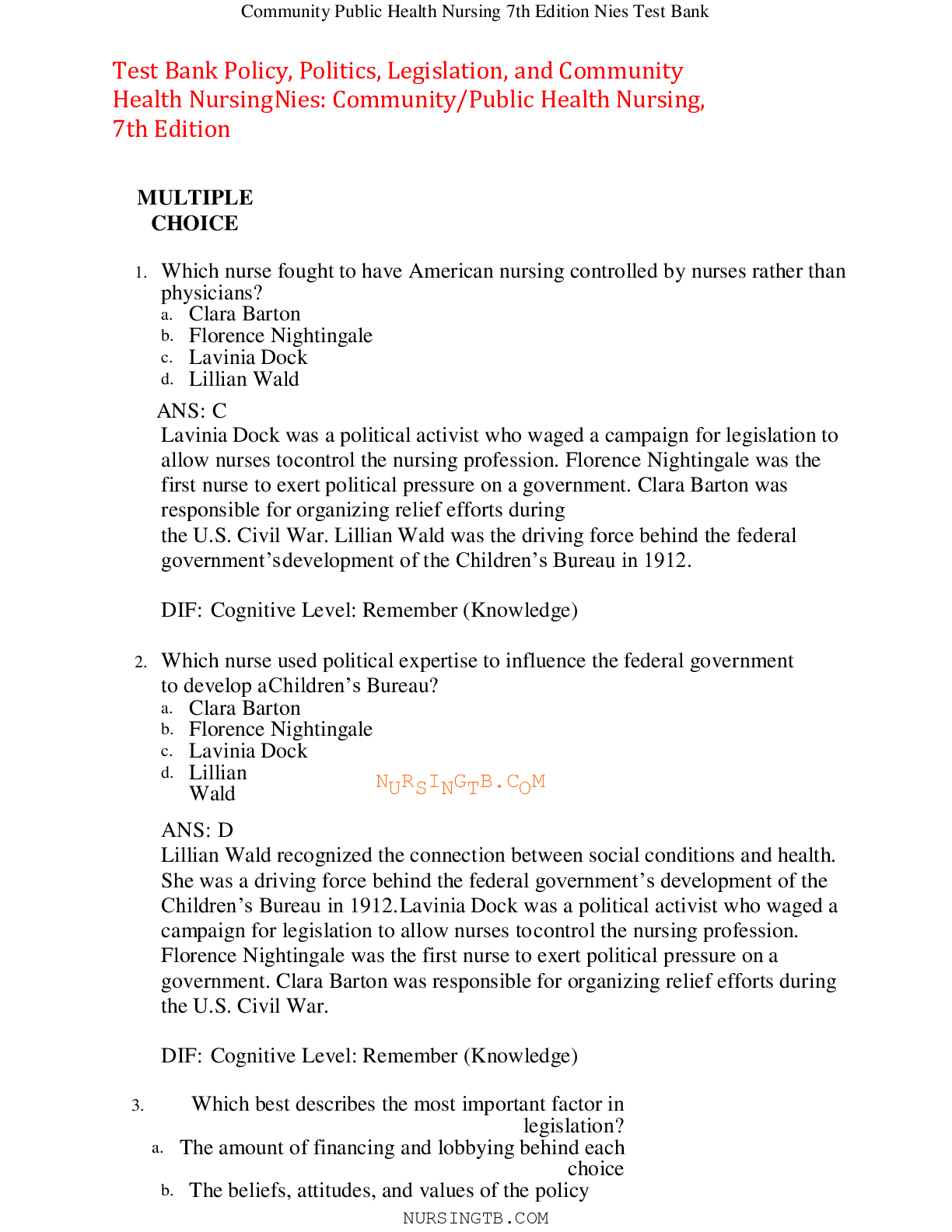


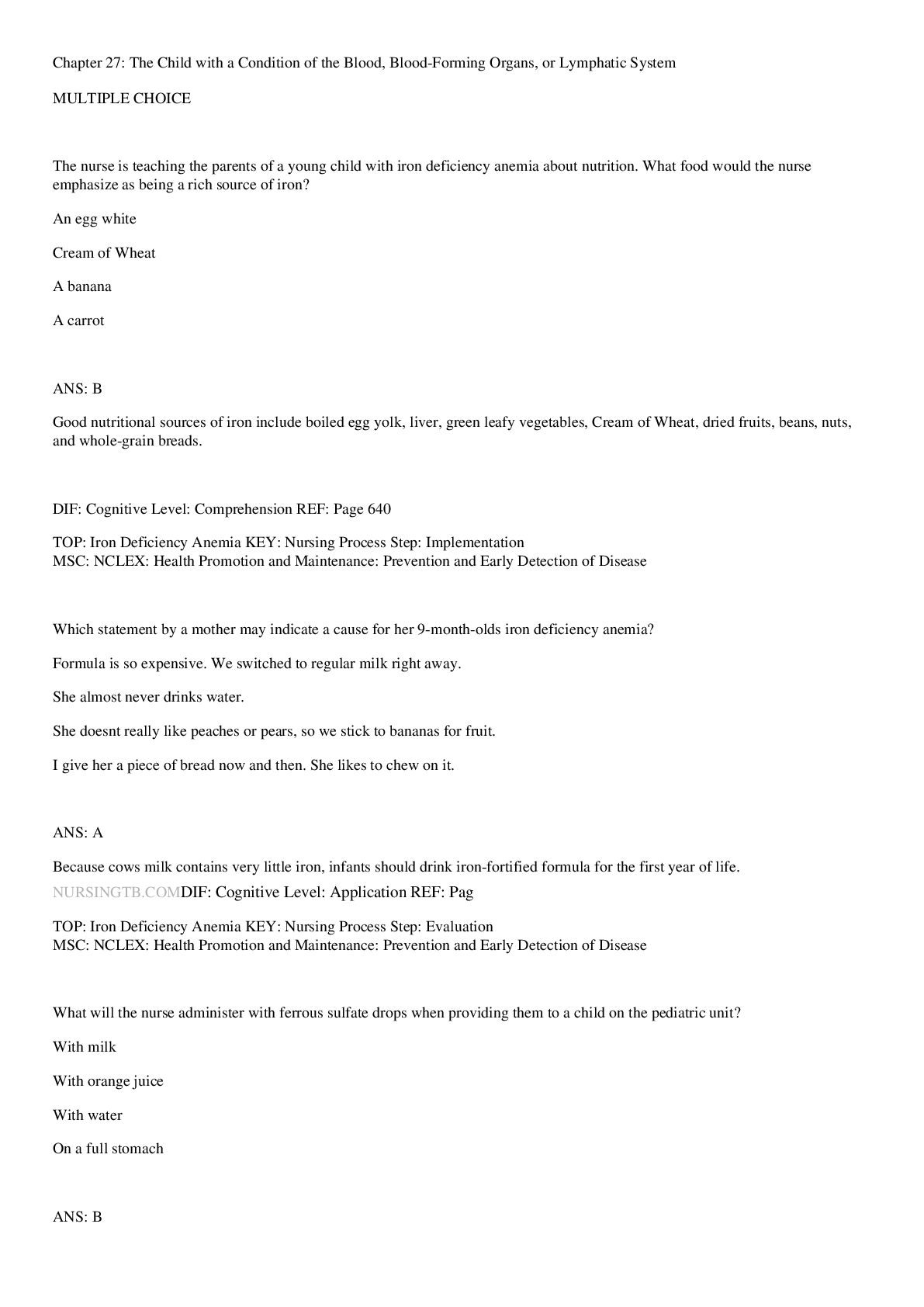



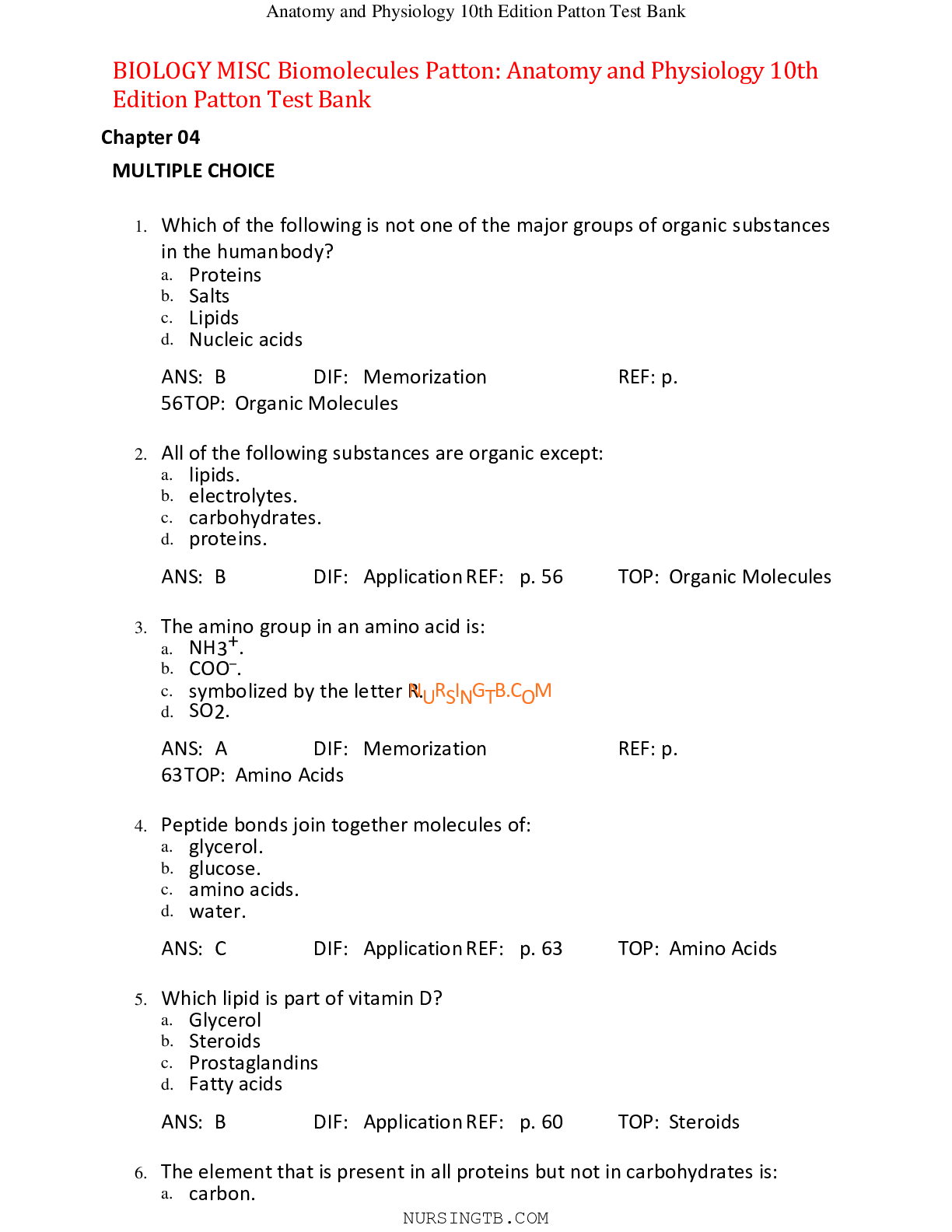





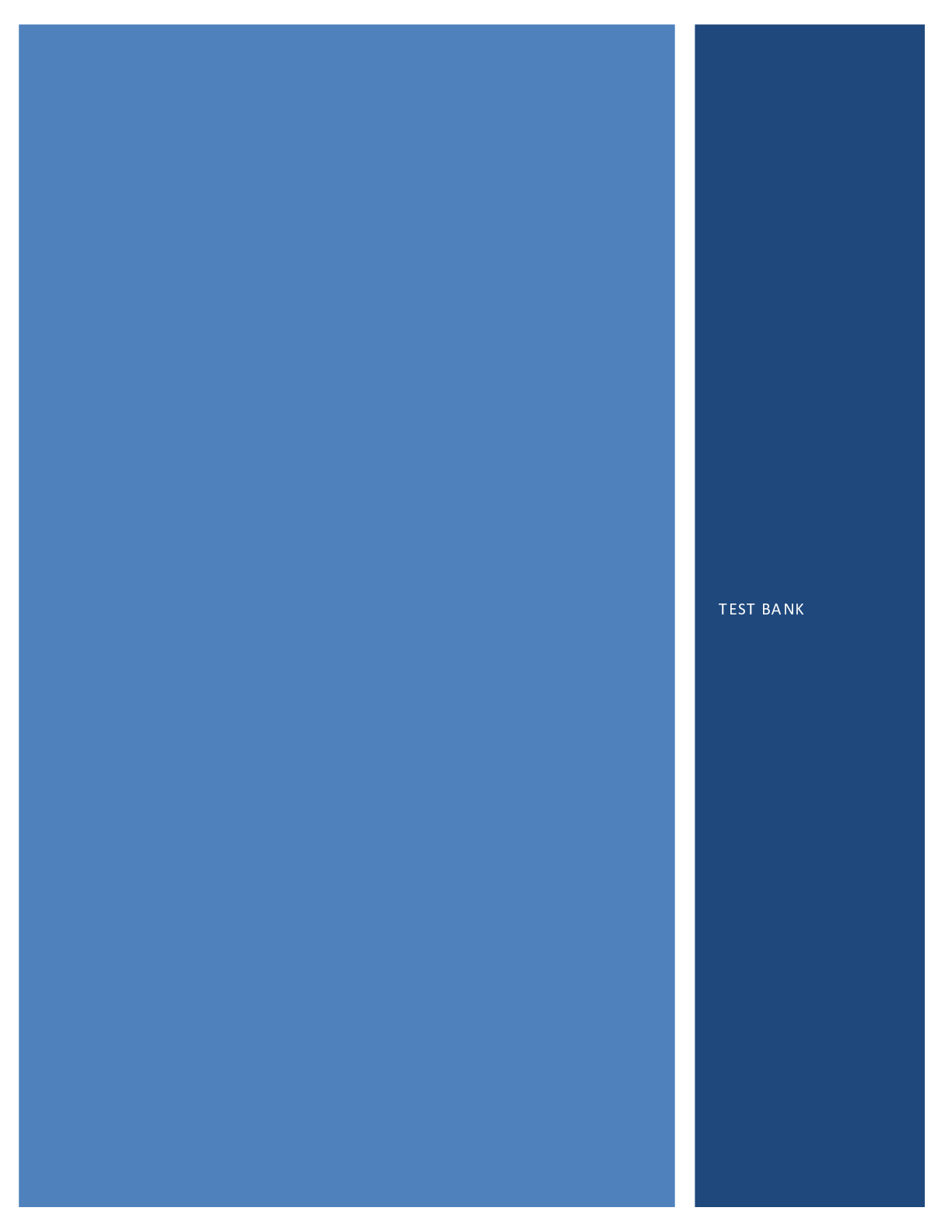


.png)
